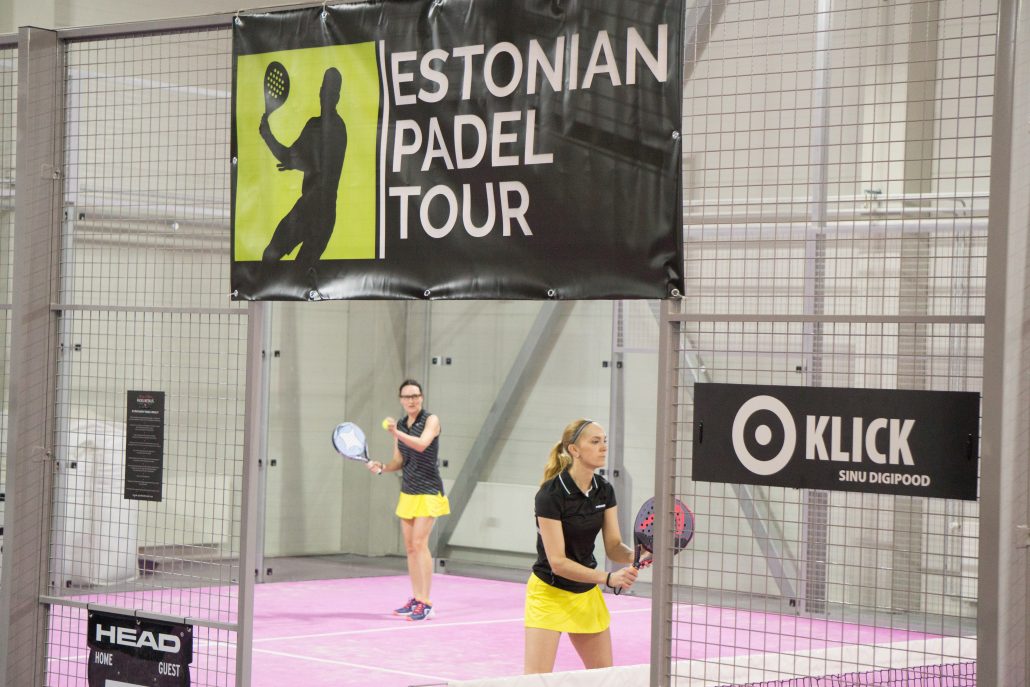Padel rackets come in a round, teardrop, or diamond shape based on the ascending skill level and strategies of the player. Furthermore, each racket has a different balance and weight, which is influenced by the materials used to construct its core (ethylene-vinyl acetate or polyethylene foam) and impact surface (graphite or fibreglass) that has several holes on both sides. Below the grip of each racket is a wrist strap that one is required to wear.
Padel is played on a 20 metre long by 10 metre wide court (indoors or outdoors, on turf, concrete, or tarmac), making it half the size of a tennis court. A three metre wall stands at each end and a fence surrounds the rest of the court. In the middle is a net that's just under one metre in height. On each side, a service line stretches across the whole width of the court, as well as there being a line going through the middle, connecting the two service lines.
Distinguishing it from other rising racket sports, such as paddle tennis and platform tennis, is the use of a low pressure tennis ball (as opposed to one made of foam rubber, or a plastic ball with holes as used in pickleball) and a thicker racket.
How do you play padel? Firstly, it's typically a doubles game. The rules are simple. As explained by the Canada PADEL Federation, a padel match commences with a coin toss, initial rally, or something equivalent to decide who serves first. As with tennis, the game scoring system works such that “the first point is 15, the second 30 and the third 40. Tied at 40 is called Deuce. Points after that are called ‘advantage to server' or ‘advantage to receiver'…” Those serving must announce the score out loud. Each team of two players “must win by two points”, or one point in World Padel Tour competitions. The first player to win six games wins a set, and the best of three sets wins a match.
To serve, players hit the ball underhand, below waist height, after it bounces once behind the service line. Players hit the ball to the other side of the net or bounce it off of the back and side walls. If you hit the ball into the net or let it hit the ground twice on your side, your opponent wins a point.
Padel Academy, run by SmashForward OÜ, describes the invention of the sport in 1969 by Mexican businessman Enrique Corcuera at his home's own squash court. Wooden rackets were used to adapt to the smaller court size. When his friend Prince Alfonso of Hohenlohe-Langenburg caught wind of the sport, he brought it to Marbella, Spain, where he had opened the Marbella Club Hotel. The number of clubs grew over the decades, and by 2013, the World Padel Series championship was hosting athletes from all over. In 2020, Singaporean sports marketing and brand agency Dejavu estimated that padel had over eight million participants, with the top two countries being Spain and Argentina.
Considering padel's similarity to tennis, what made it grow in popularity?
Padel is a sport that makes fitness and competition more inclusive across abilities and age demographics. The emphasis on underhand serves prevents players from basing their game plan on ballistic serves. Players must think cleverly about shot placement and wait for the right time to do an aggressive smash. The pace of the game is slowed by the lower pressure, and therefore decreased bounce, of the ball. Perhaps this can extend the use of all the discarded balls tennis players accumulate after their matches! And owing to its doubles format, padel is even more social and communicative.
Showing padel's sociability and adaptability is the Estonian Senior Padel Tour. Among its ranks, men and women over 40 years old play regularly and have competed in tournaments multiple times per year, including the Padel Chill Cup that was held in Pärnu in June 2021. The organization keeps a regularly updated league table, egging members on to improve their skills. And when it's all said and done, they put down the rackets and fire up the barbeque or enjoy some pizza and beer together.
Leading the charge in the teaching and promotion of padel, including for younger Estonians, is the Estonian Padel Association, founded in 2017. After their foundation, they took action to make Estonia the 34th nation to join the International Padel Federation. This all transpired within a very efficient five month period.
The commercial side of the sport is expanding, too. In 2021, Padel Company was established in Tallinn, with bookable court facilities in Ülemiste and on the rooftop of Viru Keskus. Meanwhile, the company Padel+ has its own academy and added a new club location in Kuressaare, its third location in Estonia.
If you want to try your hand at padel in Canada, you'll find that it's less available than other countries. Padel Ontario notes that there are “only a small handful of private padel courts in Ontario as of mid-2021…There are several efforts to establish a commercial and accessible padel club in the GTA.”
On November 13th, 2021, Canada's first indoor padel courts opened up in Calgary. Once people see how much fun they can have with padel, it's certain to move very quickly across the country.
Written by Vincent Teetsov
